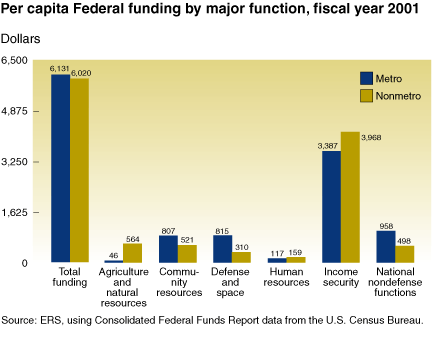Federal Funding for Rural America: Who Get's What?
- by Richard Reeder and Samuel D. Calhoun
- 9/1/2004
Federal spending and credit programs can revive or sustain rural economies. Which regions or geographic areas benefit the most from Federal funding? This question can be answered by examining the geographic distribution of Federal funds by type of Federal program. For example, high-poverty areas, such as Appalachia and the Mississippi Delta, have received above-average levels of income security payments such as food stamps and Social Security. However, these distressed areas received below-average payments from Federal community resources programs that contribute to local infrastructure, housing, and business assistance—programs crucial to economic development.
The principal source for Federal funds data is the Consolidated Federal Funds Reports data from the Census Bureau. ERS aggregates the latest available data (fiscal year 2001) to the county, State, regional, and national levels for each program and computes per capita estimates by type of nonmetropolitan (nonmetro) county. Overall, nonmetro areas received slightly less funding per capita ($6,020) than metropolitan (metro) areas ($6,131), but the amount of funding varied greatly by type or function of the program. Nonmetro areas benefited disproportionately from agriculture and natural resource program payments, income security payments (including Social Security and food stamps/other assistance to low-income individuals), and human resources programs. In contrast, metro areas benefited more from community resources programs (including infrastructure, housing, and business assistance), defense and space programs (the largest of the national programs), and national (nondefense) function programs such as criminal justice and law enforcement, energy, and higher education and research.
So which regions get what in rural America? Total Federal funding was highest in the South ($6,660 per capita) and lowest in the Midwest ($5,566 per capita), but this pattern did not hold up for nonmetro areas. The nonmetro West received the most ($6,129 per capita) due to higher-than-average payments from community resources and national functions as well as relatively high funding from human resources and defense/space functions. On the other hand, the nonmetro Northeast received the lowest funding ($5,512 per capita) as a result of lower-than-average payments for agriculture and natural resource programs.
Federal funds data indicate the types of rural places that are particularly affected by the various programs. The data can be used to address many questions about rural communities receiving funds and can help rural development programs target rural areas in need of assistance.
This article is drawn from:
- Federal Tax Issues. (n.d.). U.S. Department of Agriculture, Economic Research Service.


